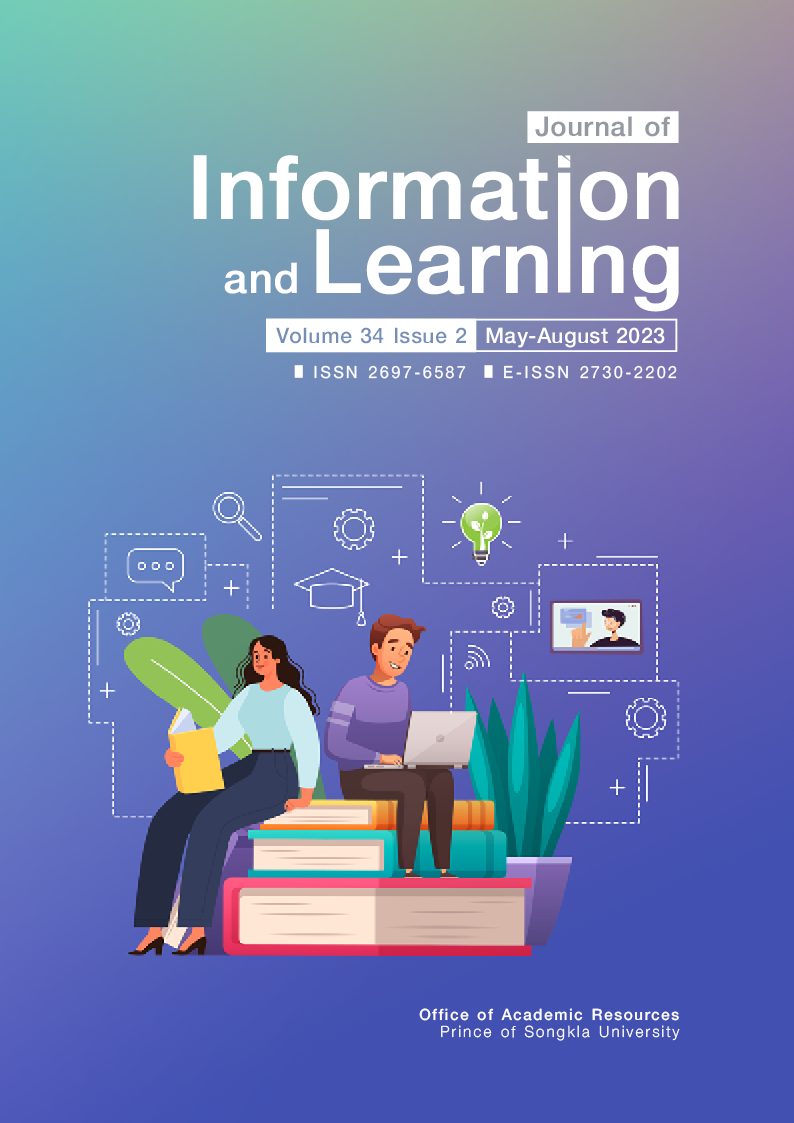Development of Virtual Learning Environment Based on Constructivism to Enhance Computational Thinking Skills in Grade 10 Students Taking Computing Science Course 1
Main Article Content
Abstract
The purposes of this research were 1) to develop a virtual learning environment based on constructivism to enhance computational thinking skills in grade 10 students taking Computing Science course 1, 2) to compare the computational thinking skills of learners before and after exposure to the virtual learning environment, and 3) to compare reflections of learners before and after exposure to the virtual learning environment. The research employed a Research and Development (R&D) design consisting of two phases, as well as a one-group posttest-only design. The target group consisted of 25 grade 10 students who were ready for a constructivist-based virtual learning environment. The research instruments included a virtual learning environment based on constructivism in Computing Science course 1, a computational thinking ability test, and a reflection assessment form. The statistics used for the analysis were mean, standard deviation, and t-test.
The findings were as follows. First of all the quality of the constructivist-based virtual learning environment was rated at an appropriate level (M = 4.63, SD = 0.55). Second, the computational thinking abilities of learners after exposure to the proposed virtual learning environment was at a good level (M = 78.55) and represented 78.55 percent at a significant level of .01. Finally, the reflection of learners after exposure to the proposed virtual learning environment was at a good level (M = 63.73) and represented 84.97 percent at a significant level of .01.
Article Details

This work is licensed under a Creative Commons Attribution-NonCommercial-NoDerivatives 4.0 International License.
The Journal of Information and Learning is operated by the Office of Academic Resources, Prince of Songkla University. All articles published in the journal are protected by Thailand copyright law. This copyright covers the exclusive rights to share, reproduce and distribute the article, including in electronic forms, reprints, translations, photographic reproductions, or similar. Authors own copyrights in the works they have created as well as the Office of Academic Resources. The Journal reserves the right to edit the language of papers accepted for publication for clarity and correctness, as well as to make formal changes to ensure compliance with the journal's guidelines. All authors must take public responsibility for the content of their paper.
References
Chaijaroen, S. (2014). The design and development of a network-based learning environment in conjunction with augmented reality technology based on Constructivist theory that promotes analytical thinking on the composition of a computer system topic for students grade 7. Veridian E-Journal, Silpakorn University, Humanities, Social Sciences, and Arts, 12(2), 1906 -3431. https://he02.tci-thaijo.org/index.php/Veridian-E-Journal/article/view/147809/146655
Hanjangsit, B., & Chaijarean, S. (2019). The design and development of a network-based learning environment in conjunction with augmented reality technology based on the constructivist theory that promotes analytical thinking computer system components for students in grade 7. Veridian E-Journal, Silpakorn University. Humanities, Social Sciences, and Arts, 12(2), 846-866. https://he02.tci-thaijo.org/index.php/Veridian-E-Journal/article/view/147809/146655
Imcham, S., & Na-Songkhla, J. (2020). Effects of online scaffolding chatbot on Computational thinking of tenth grade students with different personalities. STOU Educational Journal, Sukhothai Thammathirat open university, 13(1), 45-57. https://so05.tci-thaijo.org/index.php/edjour_stou/article/download/231423/165759/844801
Insaard, S. (2020, July 10). Management of network-based learning environment. Educational Technology Department. http://www.edu.ru.ac.th/et-ram/techno/images/environment.pdf
The institute for the promotion of teaching science and technology, (2020, November 23). Computational thinking. IPST leaning space. https://www.scimath.org/lesson-technology/item/10560-2019-08-28-02-43-20
Kanlayaprasit, N. (2021). Developing computational thinking using STEM-problem based learning in momentum and collisions topic for 10th Grade Students. Dhammathas Academic Journal, 21(4), 34-44. https://so06.tci-thaijo.org/index.php/dhammathas/article/view/250140/171412
Khuan Kalong Wittayakhom Nikhomwattana school. (2021, June 17). Self assessment report. Quality Assurance. https://sites.google.com/site/sarkklschool
Lateh, A. (2022) Classroom research. I.J. SIAM.
Office of National Higher Education Science Research and Innovation Policy Council. (2019). National education act, 1999. Policy Council. https://www.nxpo.or.th/th/1080-2
Office of the Education Council. (2017). The national education plan B.E. 2017-2036. Education Plan. https://www.stou.ac.th/Offices/Oaa/OaaOldPage/Professional/Train_Professional/oaaInfo/oaa/Dept/Dept04/webcur63/Rule_MUA/Plan_Inter2560-2579.pdf
Piaget, J. (1965). The psychology of intelligence. Rout ledge and Kegan Paul.
Srichompol, N., & Somabut, A. (2020). The development of web-based learning environment base to enhance media and information literacy on the topic the computer learning for prathomsuksa students. Journal of Graduate School, 17(76), 105-116. https://so02.tci-thaijo.org/index.php/SNGSJ/article/view/161592
Tiansawad, S. (2019, January 1). Content validation. FON CMU. https://www.nurse.cmu.ac.th/web/researchReleaseDetail.aspx?id=5092


